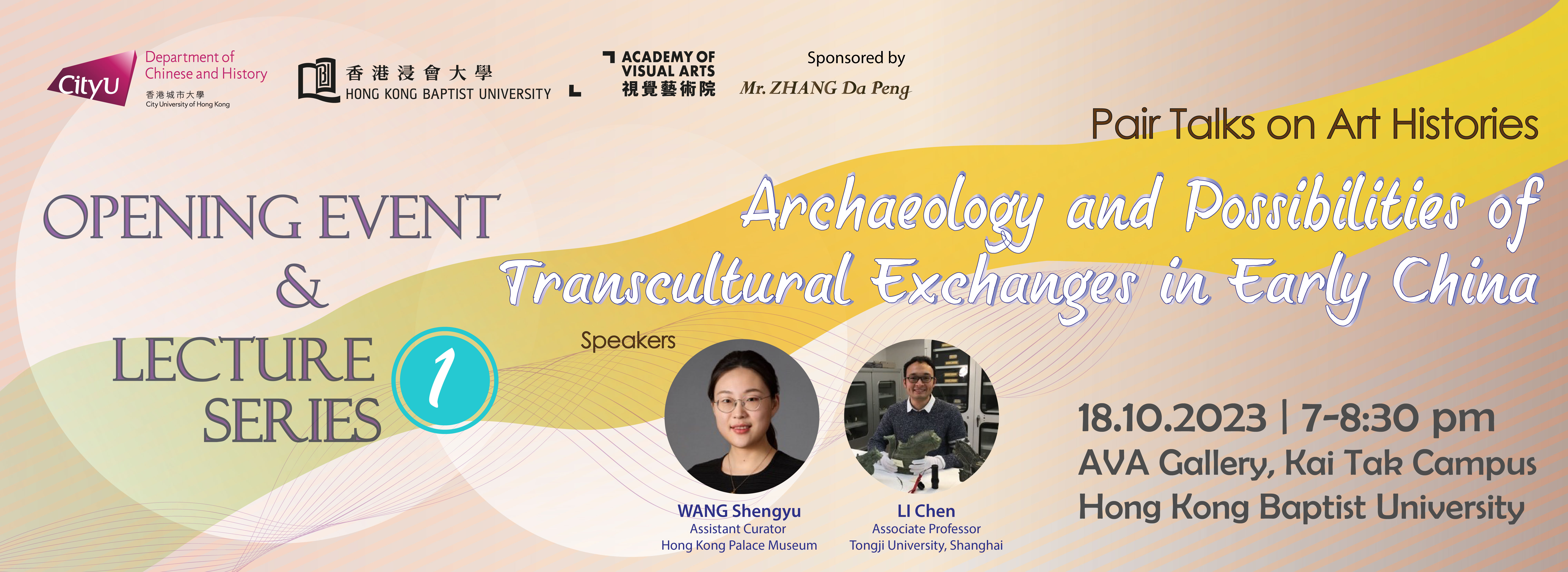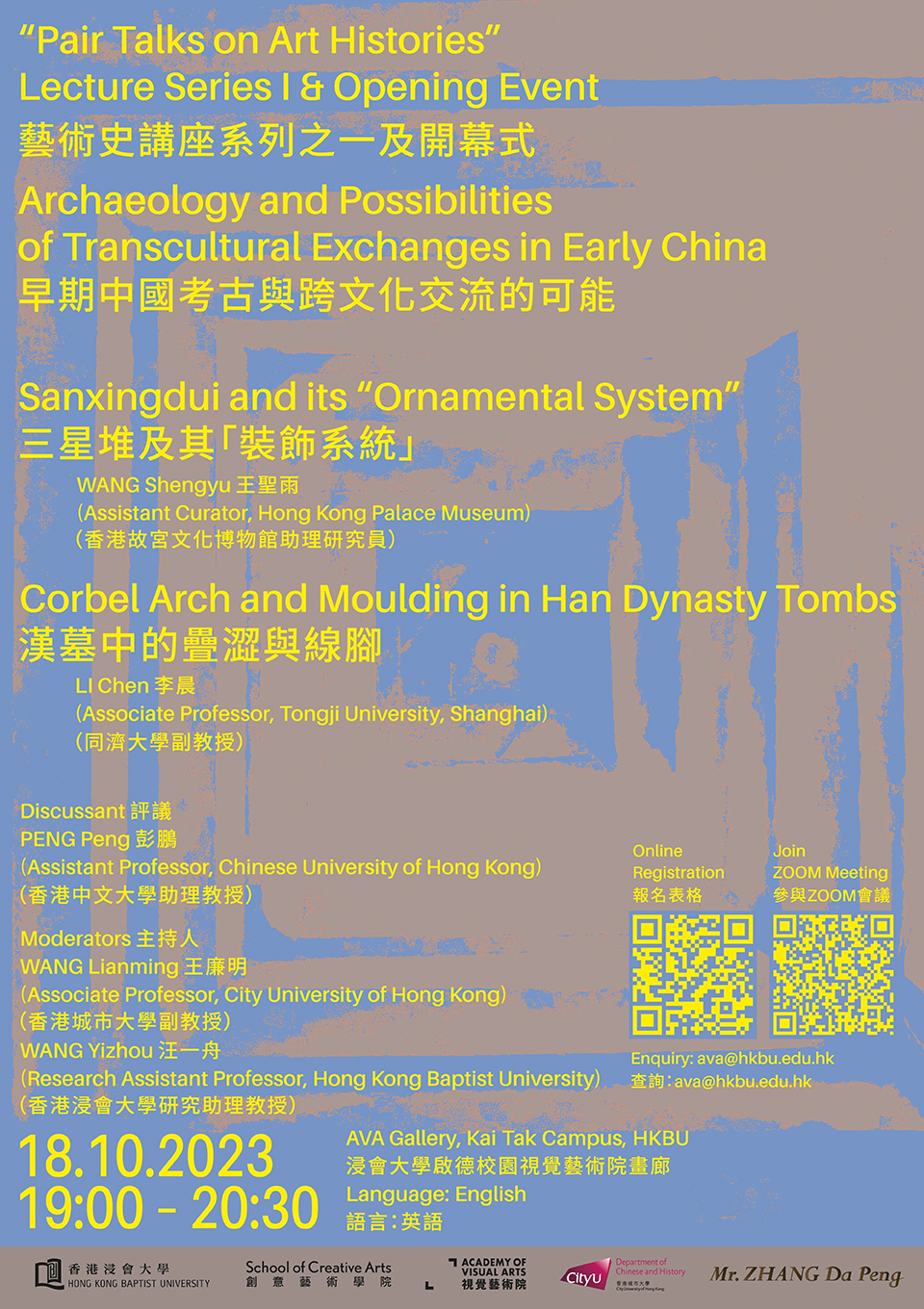
Date: 18 October 2023 (Wednesday)
Time: 7-8:30 pm
Format: Hybrid mode (Onsite: AVA Gallery, Kai Tak Campus, Hong Kong Baptist University/ Online via ZOOM)
Language: English
Speakers:
WANG Shengyu (Assistant Curator, Hong Kong Palace Museum)
LI Chen (Associate Professor, Tongji University, Shanghai)
Discussant:
PENG Peng (Assistant Professor, Chinese University of Hong Kong)
Moderators:
WANG Lianming (Associate Professor, City University of Hong Kong)
WANG Yizhou (Research Assistant Professor, Hong Kong Baptist University)
Registration
Registration is required for online/onsite participation. Please complete the online registration form on or before 16 October 2023.
Registration Closed
All are welcome!
Lecture Abstracts
Sanxingdui and its “Ornamental System” 三星堆及其「裝飾系統」by WANG Shengyu
The Sanxingdui site (c. 2500–900 BCE), located about 40 km north of Chengdu in Sichuan Province, China, has been the focus of some of the most exciting archaeological works being done in China over the past three decades. The discovery of thousands of objects made from bronze, gold, and jade fascinated scholars and the public worldwide. This presentation first briefly introduces the four fascinating facets of the Sanxingdui culture, which are also the four chapters of current exhibition at the Hong Kong Palace Museum: its art, urban life, spiritual world, and its. The presentation then critically and contextually examines some of the highly-decorated and sophisticated bronze objects, proposing that there was an “ornamental system” composed of various motifs, multiple components, and individual objects at Sanxingdui. It is argued that easily neglected material features and a contextual examination of objects across materials help us to better understand the cultural expression of worldview in a site-specific context. Possible external connections are also considered.
Speaker Biography
WANG Shengyu received her DPhil in archaeology from the University of Oxford. Prior to her current appointment as the Assistant Curator at the Hong Kong Palace Museum, she was involved in exhibitions and catalogue projects at Shanghai Museum and the Ashmolean Museum, Oxford. She has participated in archaeological excavations in China and the UK, and has published and lectured on Chinese art and archaeology in Chinese and English. At the Hong Kong Palace Museum, she made curatorial contributions to the opening exhibition “Grand Gallop: Art and Culture of the Horse”, and is co-curating a number of special exhibitions, including the 2023 special exhibition on Sanxingdui.
Corbel Arch and Moulding in Han Dynasty Tombs 漢墓中的疊澀與線腳 by LI Chen
In stone tombs of the Han Dynasty (206BC - AD220), corbel arches, also called stepped roofs, were constructed above the stone tomb chambers. A stepped roof usually consists of several parallel layers of decreasing square perimeters from lowest to highest, and is covered by a square stone slab. In profile, the space between tomb walls and the ceiling is stepped, thus the whole structure is called a stepped roof. Structure of the stone roofs and details of the carvings show very high level of stone working technologies, but they are earliest examples of corbel arches within China. Moreover, mouldings, mostly cavetto mouldings, were used to cover transitions between stone ceilings/walls and walls/floors of the stone tombs. Mouldings never appeared in Chinese decorative art before the Han, but existed in abundance in Classical antiquity, including the Hellenistic world. On the other hand, corbel arch could be traced back to Mycenaean architecture c. 1300~1200 BC, and spread across Eurasia from the Mediterranean world to West Asian and South Asia in the following 1000 years. The similarities between Chinese and Western stone structures are not likely to be coincidences or separate lines of evolution, but would suggest cultural communications along the Silk Road. This talk will reconsider Han stone structures within the Eurasian context, so as to examine the exotic elements’ possible journey to China, and to illuminate the ways through which exotica were not merely borrowed, but also assimilated within the Chinese tradition.
Speaker Biography
LI Chen is an Associate Professor at the School of Humanities, Tongji University, Shanghai. He completed his BE in Design at Wuhan University and MA in Art History at Southeast University before making the leap across Eurasia to England, where he obtained his DPhil in Archaeology under the supervision of Professor Dame Jessica Rawson at the University of Oxford in 2014. His main research interests include art and archaeology of early China, structures and contents of ancient tombs, as well as interactions between Central China and the rest part of Eurasia. He has published an English book as well as a number of peer-reviewed Chinese and English articles, one of which won the Young Scholar Award, European Association for Chinese Studies. He has just completed a research project funded by the National Social Science Foundation of China, and is finishing his second book on the construction of Han Dynasty stone tombs.








